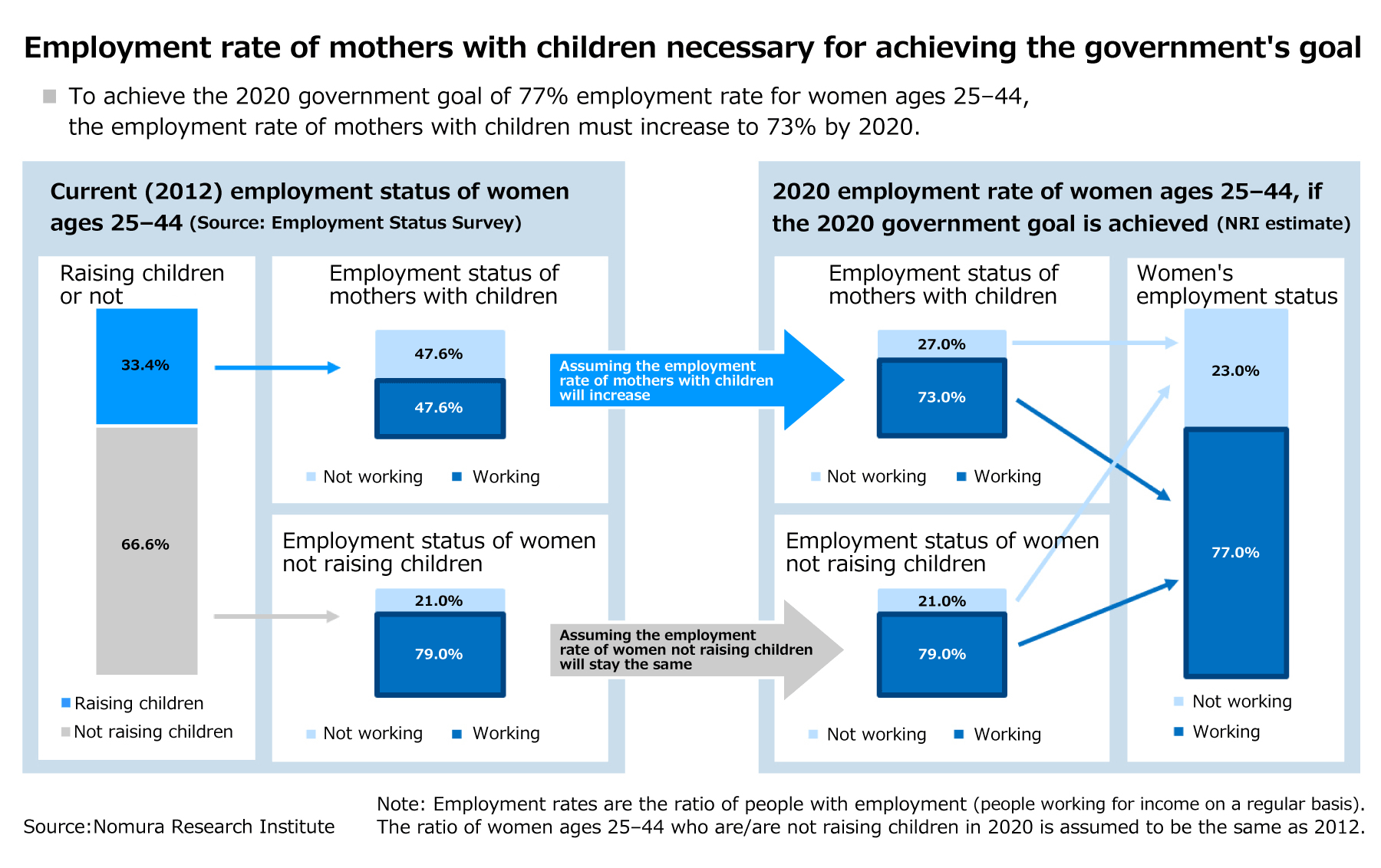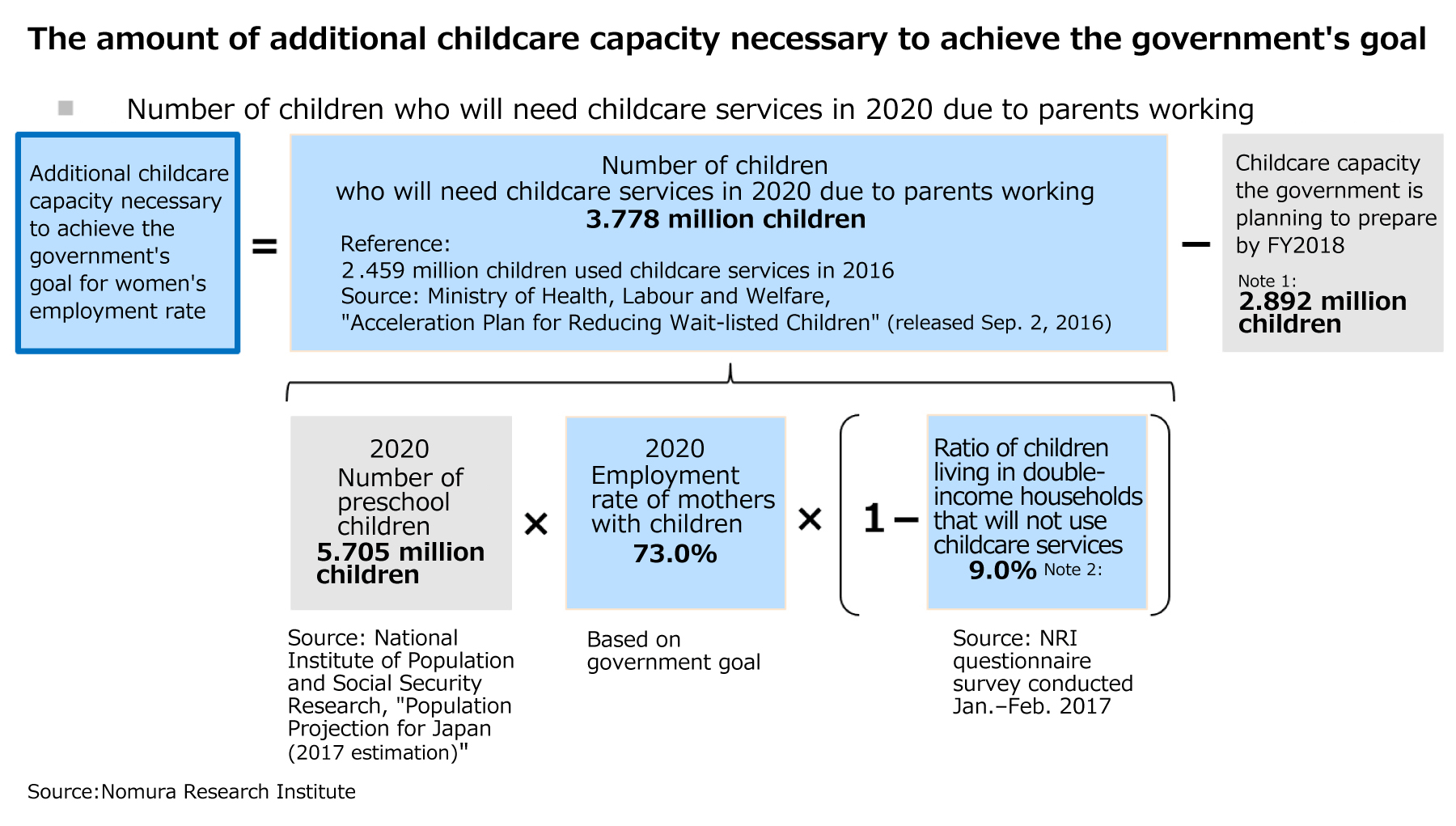
Childcare for 886,000 more children by 2020 to compensate for the diminishing workforce
In order to achieve the Japanese government's goal of a 77% women's employment rate by 2020, Japan must bring up the ratio of working mothers to 73%. This is about the same as the employment rate of women who are not raising children. The country will need to increase its childcare capacity for 886,000 more children, in addition to the childcare services the government is already planning to provide. Here, we will present NRI's prediction.
Shifting focus from the large number of children on waiting lists to the need to increase women's employment rate
NRI's Kana Takeda is an expert on working women and their awareness, and has researched the childcare capacity and childcare services that Japan will need in the future. Takeda was motivated by a certain awareness.
"The problem of children on waiting lists for childcare has evoked much discussion but no conclusion has been reached. I believe the cause for this is because the discussions focus on exactly how much the services should satisfy the needs of parents, and also because there is a big awareness gap regarding childcare services between the user and supplier, that is, the parents and municipalities. In that case, I wondered if I could shift the focus from how to resolve the existing problem of children on waiting lists, to exactly how much of a childcare capacity the country needs to guarantee Japan's workforce. I hoped this would create a ripple towards enhancing childcare services in the future. I looked at the government's 2020 goal for women's employment."

Sufficient childcare services are needed to compensate for the workforce los
As Japan's working population diminishes, caused by a falling birth rate and aging society, the government aims to increase the employment rate of women and senior citizens. Their goal for the employment rate of women between ages 25 and 44 is 77% by 2020. Assuming the provision of sufficient childcare services will lead to a higher employment rate for mothers with children, Takeda looked into how much the childcare capacity lacked in comparison to the goal. According to her estimates, by 2020, Japan needs to see a 73% employment rate for mothers with children. From this number she deduced the necessity of an additional childcare capacity for 886,000 children. This is almost the number of children born annually in Japan.
"If we can increase the childcare capacity by this much, we can expect the number of working parents to increase by 675,000. This is based on the assumption of an average of 1.3 children to each parent. According to the 2015 Report by the Employment Policy Study Group, the Ministry of Health, Labour and Welfare, Japan is expected to lose up to 3.05 million people in the workforce by 2020. Even with that estimate, a sufficient childcare capacity could compensate for 20% of the lost workforce."

Parents of approximately 310,000 children say they "want to use childcare services but are not able to"
In late January 2017, Takeda conducted a questionnaire on childcare services targeting 3,708 men and women with preschool children in Japan. Based on the results, she estimated the number of parents unsatisfied with current childcare services.
Firstly, of the 3.12 million parents who are not using childcare services, more than half (1.8 million) want to use them. Moreover, parents of 313,000 children said they would use them immediately but are not able to. Of this number, an estimated 137,000 children are in single-income households and are not using childcare services, and Takeda says this means the parents of around 137,000 children "may have started working as soon as childcare services were available."
Firstly, of the 3.12 million parents who are not using childcare services, more than half (1.8 million) want to use them. Moreover, parents of 313,000 children said they would use them immediately but are not able to. Of this number, an estimated 137,000 children are in single-income households and are not using childcare services, and Takeda says this means the parents of around 137,000 children "may have started working as soon as childcare services were available."
An investment with an economic effect equivalent to 5 trillion yen
Based on this survey, NRI estimated how sufficient childcare services would impact Japan's economy. If childcare services can fulfill childcare for 886,000 children, expenses for the additional facilities are estimated to be 1.4 trillion yen. On the other hand, assuming this will lead to the employment of 675,000 parents in permanent jobs, Japan can expect an income growth of 2.8 trillion yen. This figure is highly feasible with stable employment, and a majority of this income growth will be used for consumption. Because of the chain reaction of economic transactions, the generation of demand has a positive impact on manufacturing and raw materials production, and when considering this ripple effect, the overall economic effect is thought to be over 5 trillion yen. In other words, the 1.4 trillion yen in expenses for additional childcare services can be considered an investment with a return of "675,000 more people in the workforce and an economic effect of 5 trillion yen."
NRI believes it is important to facilitate discussions regarding Japan's childcare capacity with a focus on workforce repletion and economic growth. It is crucial for Japan to make bold moves to accelerate the government's efforts, including those designed to ensure funds for additional childcare services, while utilizing private resources in both quantity and quality.
Moreover, NRI continues to research the actual and intended usage of childcare services, and is now estimating the number of children with parents who wanted to use childcare services starting April 2017 but were not able to.
Profile
-
Kana Takeda
* Organization names and job titles may differ from the current version.